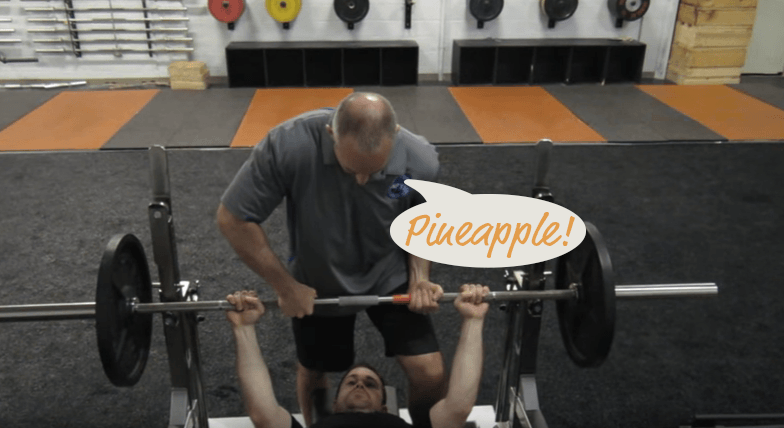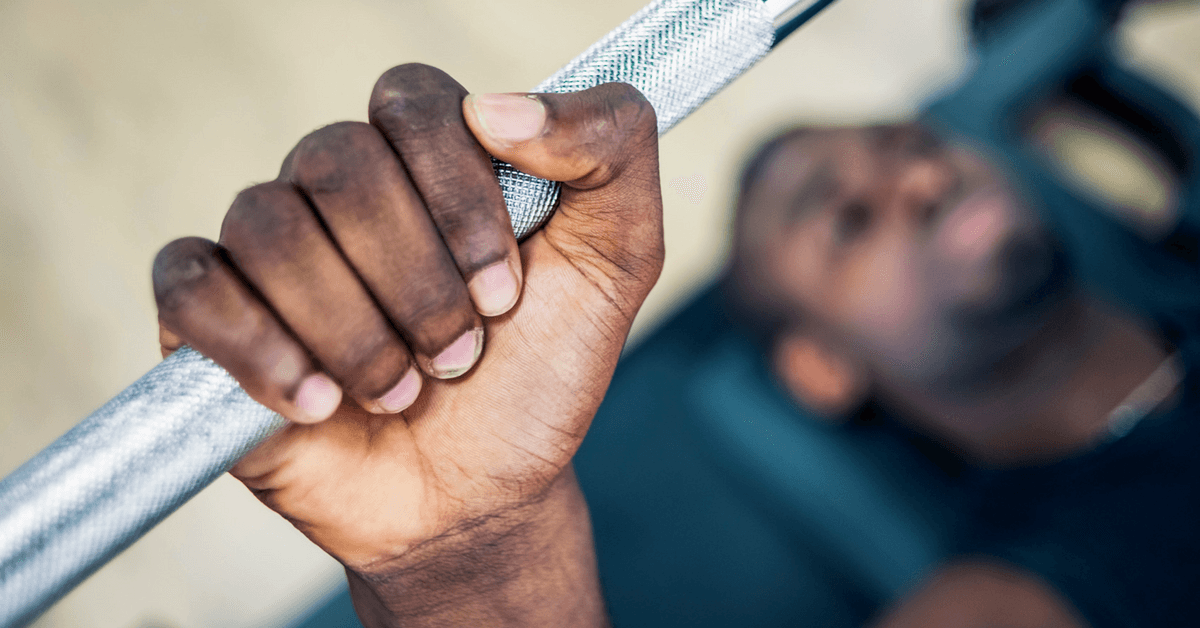A key part of your job is to make sure the client doesn’t get crushed or injured while lifting weights. In a failed lift, a client might panic and all hell can break loose, which is bad if that hell weighs as much as (or more than) you or your client does.
Keeping the client safe is obviously important but what nobody seems to talk about is how to keep yourself safe. This is an unfortunately overlooked consideration. Keep yourself safe. Spot correctly. You don’t need superhuman strength to be a good spotter. You simply need to learn the proper technique and exactly what and how to keep yourself safe.
This article focuses on spotting considerations for the three major lifts: bench press, squat, and deadlift. Each section is split into a few parts:
- A video demonstration
- Some important info to consider
- How to stand
- A step-by-step checklist
Here’s what you need to know.
The right way to spot a bench press
In the video above, you can see my best practices for spotting a bench press. The main point here is that you are in charge. If at any time you are not sure that you will be able to properly spot a subsequent rep, instruct the client to rack the weight, even if the client wants to keep going. It’s not worth it--for either of you.
How you should stand
* Stand near the client’s head on the other side of the bar.
* Keep your knees soft and your body as close as possible to the barbell without getting in the way of your client. Some benches may require you to step over one of the supports to do this.
* Prepare to mirror the bar with your hands as it goes up and down without actually getting in the way of the bar path. Help out only if the client needs assistance. Perhaps you can come up with a sort of “safe word” beforehand. My safe word is “pineapple.”

A very common error I see is that trainers tend to stand too far away from the bar. They want to give the client their personal space, and that is fine; but by the time the client lifts the bar off the racks and brings it over their chest, the trainer is two feet from the bar. In this instance, you lose all of your leverage, and worse, that angle puts a lot of pressure on your lower back. Instead get close to the bar, keep your knees soft, and mirror the path of the bar by bending your knees.
Step-by-step checklist:
1. Help the client removing the bar from the racks (known as the lift-off), but only if the clients wants you to. If he does, make sure the client takes the bar with the arms extended. Additionally, you should give some sort of clear indication that you will be letting go of the weight. Saying “All you” works.
2. Use an alternate grip (one hand with an underhand grip and the other with an overhand grip) to have a firm grip on the bar.
3. Take a firm hold of the bar in-between the client’s hands. The exception to this is if the client is performing a close-grip bench press.
4. Don’t jerk the bar up, or pull the bar close to you making it awkward for the lifter. Provide just enough assistance to keep the bar moving at normal speed and following its normal bar path.
5. Once you spot one rep, your client likely needs help on all the subsequent reps. Anything more than four forced reps is likely excessive (and even that is pushing it), just rack the weight at that point.
6. Don’t do an upright row to help your client. Instead, perform a variant of a deadlift, using your back and legs to help the client lift the weight. The heavier the client is lifting the more important this is.
The right way to spot a squat
The two most important features to ensure a client’s safety is to have him squat inside a power rack and set up the safety pins at the right height (an inch or two below the bottom position of their squat). That way, if a client tries to “dump the bar,” which is when he throws the bar behind him to get out from underneath this rod of death, the safety racks will catch it.
But if you’re spotting, this could be a very painful experience for both parties that could lead to injuries. Instruct the client to stay with the bar. Even after you do, some clients will panic if they feel like they are going to fail and will attempt to bail on the lift, especially if they have done that in the past. As they get closer to failure, remind them during the set to stay under the bar and that you’ll keep them secure.
With squats, it’s also important to let your clients know that you will be touching them around their torso and to make sure you get permission from them to allow you to do so.
How you should stand
* Prepare yourself to squat with good form because you’ll be squatting down with the client.
* Your chest should be a few inches away from their back, and your hands a few inches away your client’s front delts/upper chest area.
* If a client requires help walking the weight out, you can either put your hands on the bar, in-between your client’s hands or under his shoulders to help steady them as he walks backward. If possible, encourage your client to do this part of the lift by himself.
Keep in mind that your hands should be around the torso and on the front delts (not the waist). That’s because when a client fails on the squat, two things are likely to happen:
1. He will likely fall down and/or forward (often a combination of the two). Placing your hands on his waist only helps prevent him from falling down, so you need to put your hands on their upper chest/front delt area to prevent them from also falling forward.
2. If you put your hands on a client’s waist and the client doesn’t feel like he’s getting enough help from you, he might dump the bar backward, which happens to be right where you are. Not good. Essentially, you should make this very clear with the client:
“I will spot you correctly and I will keep you safe; you stay under the bar and you help keep me safe.”
Step-by-step checklist:
1. Mirror the client. He goes down, you go down--using your legs to squat down with him.
2. Keep your hands a few inches under their shoulders, making sure not to get in the way of their natural lifting form.
3. When the client needs help, put your hand on the upper chest, around the front delts; or if the weight is heavy, hug the client so that your chest contacts his back and move the weight up together. If your client is female, you can use a closed fist (palm up) and move the hands out just slightly so they are closer to the front delts.
4. Don’t wait as long to spot a client on the squat as you might a bench press. Unless the client is extremely advanced and trying a 1RM, once the bar stops moving upward, quickly provide enough assistance to get the bar moving again.
5. Apply enough extra force. You need to “help” more than you would on a bench press. Let’s say if a client only needs 10 percent help on a bench, that might mean you help by adding 15 pounds of upward force on the bar. On the squat, that same percent might mean you are adding 30 pounds of force to the bar.
6. Once the client is standing tall, you can move your hands to the bar to help them walk the bar back into the racks.

If both you and your client are unable to stand up, guide them down to the safety racks and let the safety racks support the weight. Then escort the client out from under the bar. Also, rethink the weight or the intensity you selected for that client, as that should not happen with any regularity.
One thing to note is: Never spot the bar itself. Otherwise, you’d better be able to curl your client’s squat weight.
The right way to spot the deadlift
Here you want to crawl under the bar while the client is lifting and bench press it up…
I’m joking.
DO NOT spot the deadlift.
But you should still coach it correctly.
If the client can’t handle the weight or can’t complete the movement, he simply drops it. No harm done. You should, however, continue to provide cues and proper feedback to keep their deadlift technique proper and sound. If the client fails, or more commonly if their form breaks down (their lower back starts to round, for example), instruct your client to return the weight to the floor.
Be careful of picking up objects yourself
Speaking of deadlifts, trainers are constantly picking up weights and other objects from the floor. You have probably heard of people who’ve hurt their back from reaching into the dryer to get a sock or picking up a pencil from the floor. In those cases, it obviously wasn’t the weight of the object that caused the injury, but likely the repeated movement pattern of utilizing poor form. So that final motion was just the straw that broke the camel’s back. Here are two tips to keep yourself safe:
1. Use the proper form that you teach your clients when picking up objects from the floor, even if they are not that heavy for you. There is a reason we deadlift the way we do and coach it the way we should.
2. Don’t put something on the floor if it doesn’t need to go there in the first place. For example, think of how often you might toss your client’s training log on the floor while you spot them. Then after every exercise, you have to bend over to pick it up, take it to the next exercise, and repeat the process. It may not seem like a big deal when you are young and limber, but all of that repeated flexion and extension can add up, day after day, year after year. Instead, set the workout log on a bench, a weight rack, or some other place that is easier to reach. You can do this with light dumbbells or weights that you are loading/unloading before you officially put them away.
Finally, here’s a bonus tip for unloading the bar a better way:
Being able to spot your client is a good way to boost a client’s confidence and trust in you. But don’t get so carried away that you totally neglect your own safety and lower back health. You need to keep yourself healthy and happy in order to provide an excellent service to your clients as well.









